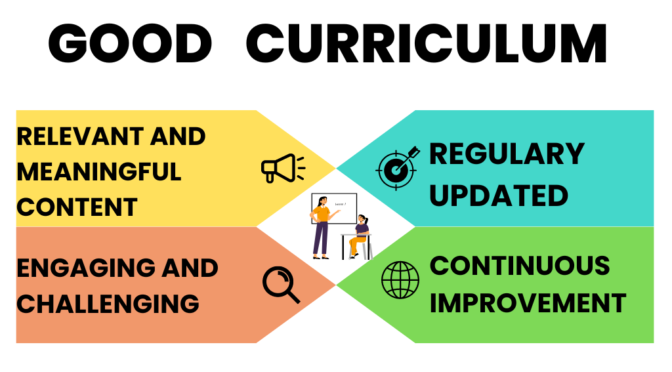A good curriculum is essential for effective teaching and learning. It provides a clear framework for educators to guide their instruction, and it ensures that students acquire the knowledge and skills they need to succeed in school and beyond.
Here are some of the characteristics of a good curriculum:
- Clear and coherent structure:
A good curriculum should have a clear and coherent structure that is easy for educators to understand and implement. It should include a set of learning objectives, a sequence of instruction, and assessments that align with the objectives. The structure should be consistent across grade levels, subjects, and schools to ensure consistency and continuity in learning.
- Relevant and meaningful content:
A good curriculum should be relevant and meaningful to students. It should be designed to meet the needs and interests of the students and should include real-world examples and applications. It should also reflect the cultural and linguistic diversity of the student population.
- Standards-based:
A good curriculum should be aligned with academic standards, such as state or national standards. The standards should be clear and specific, and the curriculum should provide a roadmap for teachers to help students achieve the standards. The curriculum should also be updated periodically to reflect changes in the standards.
- Engaging and challenging:
A good curriculum should be engaging and challenging for students. It should include activities that are interactive, hands-on, and relevant to students’ lives. It should also provide opportunities for students to apply their knowledge and skills in new and complex situations.
- Differentiated:
A good curriculum should be differentiated to meet the diverse needs of students. It should include strategies and resources to support students with different learning styles, abilities, and backgrounds. It should also provide opportunities for advanced students to deepen their learning and for struggling students to receive additional support.
- Formative and summative assessments:
A good curriculum should include both formative and summative assessments. Formative assessments are used to monitor student progress and adjust instruction as needed. Summative assessments are used to measure student achievement at the end of a unit or course. Both types of assessments should align with the learning objectives and provide useful feedback for students and teachers.
- Continuous improvement:
A good curriculum should be continually improved based on feedback from students, teachers, and other stakeholders. It should be reviewed periodically to ensure that it is effective and relevant. The curriculum should also be flexible enough to adapt to changes in technology, society, and the needs of students.
Also Read : Curriculum Change
In summary, a good curriculum should have a clear and coherent structure, include relevant and meaningful content, be aligned with academic standards, be engaging and challenging, be differentiated to meet diverse student needs, include both formative and summative assessments, and be continually improved based on feedback.
Also Visit : Prep with Harshita



I have observed that over the course of developing a relationship with real estate proprietors, you’ll be able to come to understand that, in most real estate purchase, a payment is paid. Finally, FSBO sellers tend not to “save” the commission payment. Rather, they try to earn the commission by doing a great agent’s task. In the process, they expend their money and also time to conduct, as best they will, the jobs of an agent. Those tasks include disclosing the home by marketing, presenting the home to buyers, making a sense of buyer emergency in order to make prompt an offer, scheduling home inspections, handling qualification checks with the mortgage lender, supervising repairs, and facilitating the closing.
Thanks for sharing. I read many of your blog posts, cool, your blog is very good.